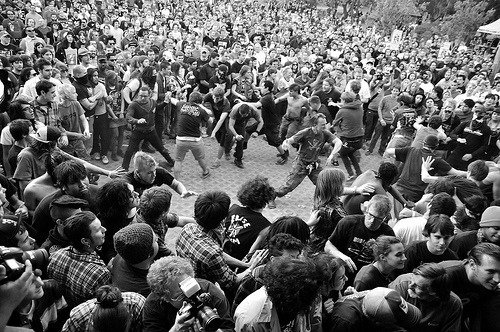Still Relevant? Of course
It’s hard to believe that twenty-one years ago, Nevermind,
Nirvana’s 1991 sophomore album, was released. It was full of angry, angst-filled anthems like “
Smells Like Teen Spirit” and rebellious ballads like “
In Bloom.” It showcased the musicianship of legendary Kurt Cobain and led to the rise of the world’s nicest rock star Dave Grohl. It opened the doors for a whole new brand of music that aligned itself somewhere in the middle of rock, pop, punk, metal, and really any other genre you can think of. There is a reason that when you think of music from the 1990s, you immediately think of Nirvana. And that reason was, and still is, Nevermind.
In 1989, Nirvana released their debut album Bleach. It was a dirty, disorganized album of metal slosh, almost like an
early Soundgarden record. It had little originality, and had it not been for the sole pop song on the album “
About a Girl,” it may have marked an early end to Nirvana. But, the band pushed through, thankfully, into the 90s.
The band went through a slew of drummers until 1990 when the band hired Dave Grohl to join the trio, comprised also of guitarist and singer Kurt Cobain and bassist Krist Novoselic. Adding Dave Grohl was probably the best decision the band ever made.
Listening to Bleach and going straight into Nevermind, you hear a drastic change, and Dave Grohl’s influence becomes evident with his harmonizing backing vocals and a drum intro to “Smells Like Teen Spirit” that is probably more hummable than “Smoke on the Water.” With Nevermind, Kurt and Krist had a whole new setting: they had Dave Grohl, they had producer Butch Vig, and they had an army of fans behind them.
When Nirvana exited the studio, they had recorded a masterpiece. It was a new sound, and a sound that had never been made before. It wasn’t metal, but it wasn’t pop, nor was it rock. This new genre was deemed grunge.
 |
| From left: Kurt Cobain, Krist Novoselic, Dave Grohl |
The birth of grunge has been an argued topic for, well, around twenty-one years. For instance, Soundgarden and Mudhoney, two of the forerunners of 90s alternative rock, had been truckin’ since the late 80s. Nirvana re-invented the sound that Soundgarden and Mudhoney had failed to commercially extort, though the two would soon follow in Nirvana’s path, as well as Pearl Jam, Alice in Chains, Bush, Stone Temple Pilots, and countless others inspired by Nirvana’s efforts. Kurt Cobain’s lyrics on Nevermind were self-loathing, depressing, and often disturbing. He was a vehicle of faith for depressed teenagers. People could connect to him. It made Kurt Cobain a spokesperson for
Generation X, and that made Nirvana the flagship band of the 1990s.
All of the songs on the album still hold up after over twenty years. “
Lithium” is as wild and disgustingly catchy as ever and “
Polly” is just as bone chilling as it was when Kurt was still singing it live. Listening to “
Drain You” provokes the thought that Dave Grohl had more to do with the songwriting than the media let on, given that the Foo Fighters song “
This is a Call” sounds strangely similar to it, which of course wouldn’t come out until around four or five years later. Other songs like “
Stay Away” and “
Lounge Act” seemed so graphic and offensive, but now, one drop of the F bomb and a derogatory comment about God are child’s play compared to massive amount of red-bannered ‘explicit’ icons on iTunes playlists today. Nirvana was not the first band to go against the pop radio hits and curse in their songs, but they did it with such hate, with such rebellion, that it opened up a door that can’t be closed. That door fueled the angst and rebellion of contemporary bands like Cage the Elephant and the Vines.
Nevermind perfected a system invented by the Pixies. Kurt Cobain was a large fan of the quiet-loud-quiet song structure, in which there would be a quiet verse with softly sang words, followed by a heavily distorted, very loud chorus with screaming vocals.
Nirvana’s third and final album In Utero would soon follow. Though it would not be as commercially successful as Nevermind, it still ignited a simple flame that would soon burst into an inferno known as the
Foo Fighters, with the connections there being obvious upon first listen.
 |
| Foo Fighters - What Nirvana might've become |
After Kurt Cobain killed himself in 1994, he became a visionary artist and Nevermind was his finest piece. The suicide showed us all that Kurt was a truly troubled individual, whose drug abuse and emotional self-inflictions led to his downfall. But, did he ever really fall? Some argue that the death of Kurt Cobain was an inevitable turning point in pop culture history, making the few works of art he created all that more inspirational. Had Kurt survived his battle with heroin addiction, would the Foo Fighters exist today? Would Nirvana still be the leading alternative rock band, or would they have burnt out faster than a hippie’s dad at a Dave Matthews’ concert?
We’ll never know if Nevermind would have been Nirvana’s finest work, or if “Smells Like Teen Spirit” would have been outdone by an even stronger anthem by Kurt Cobain. However, Nirvana’s contributions to music, while few, are bested only by a handful, such as John Lennon or Bob Dylan.
Nevermind didn’t eliminate the underground; it only exposed it, and after all these years, it still inspires music and people today.













